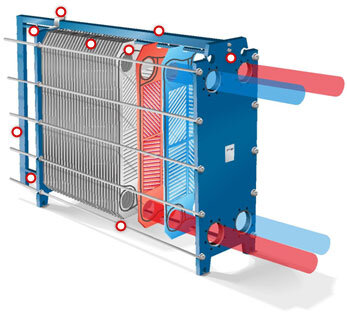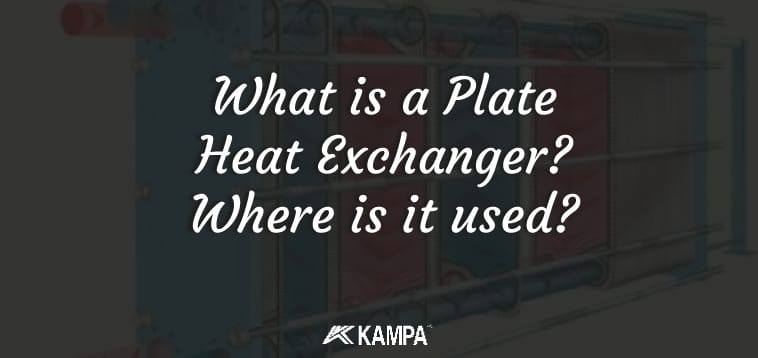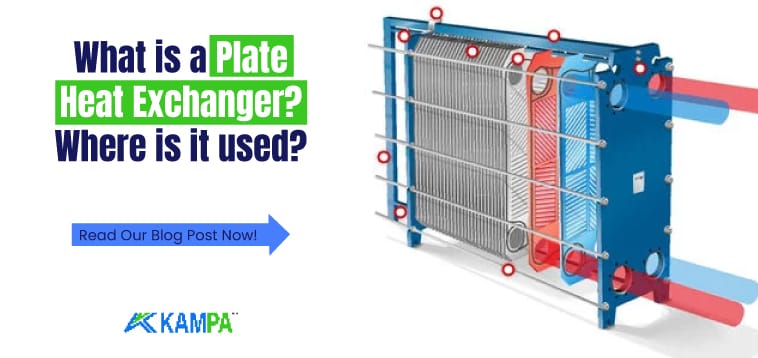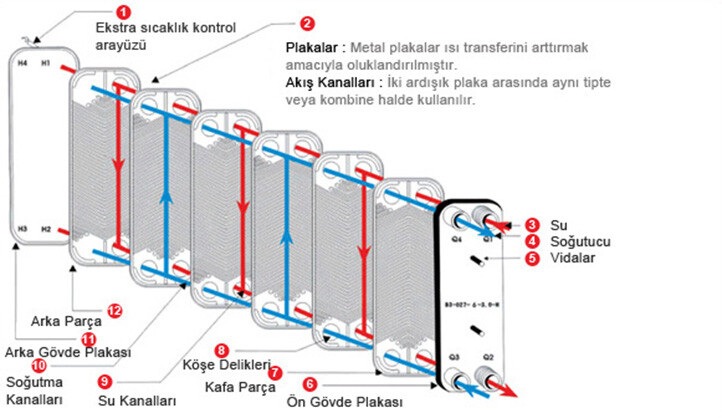What is a Plate Heat Exchanger? Where is it used?
What is a plate heat exchanger? It was first produced in the 1920s and is widely used in heating and cooling systems in numerous industries.
A plate heat exchanger consists of parallel plates placed one on top of another in a series of high quality channels for fluids to flow between them.

The space between the two adjacent plates forms the channel through which the fluid flows.
Inlet and outlet holes in the corners of the plates allow hot and cold fluids through alternating channels in the exchanger so that one plate is always in contact on one side with the hot fluid and the other with the cold.
In our previous blog post, we explained general technical information about the plate heat exchanger, which is used in every field from industry to combi air conditioners. In this blog, we will talk about the plate heat exchanger.
In general, these plates are corrugated to increase turbulence, thermal exchange surface and provide mechanical stiffness to the exchanger.
The corrugation is obtained by cold forging 0.3 mm to 1 mm thick sheets.
The most commonly used materials for plates are stainless steel, titanium and aluminum.
The groove in the plates forces the liquid on a curved path and creates a gap (1 to 5 millimeters) between two adjacent plates.

Fluids can pass through the channelsin series (a less common solution), counter-current or in parallel by makingcurrent configurations.
Theseries configuration is used when there is a small flow rate for each fluid, but high heat lapse; the biggest problem is the high pressure drop and a perfect countercurrent.
The parallel configuration withcounter-current channels is used for high flow rates with moderate temperature drops and is most commonly used.
When there is a large difference between the flow rates (or maximum allowable pressure drop) of the two fluids, the heat exchanger can operate with a twice lower flow (or higher losses) by the fluid, for pressure reduction or balancing of specific values.
One of the most common problems for plate heat exchangers is that all channels are unevenly fed in parallel. In fact, to compensate for the pressure drop, the fluid tends to disperse in greater quantities in the first channels rather than in the last channels.
There are two basic types of plate heat exchangers: Brazed Plate Heat Exchangers and Plate heat exchanger.
Plate Heat Exchanger

To form the plates, the frame boards are pressed with headers and tie bars and connected by adding gaskets.
In addition to the sealing effect, the gaskets serve to direct the flow of fluids and are placed along the grooves on the edges of the sheets.
The maximum temperatures used for sealing heat exchangers are between 80°C and 200°C and pressures can reach 25 bar.
Gaskets are available in butyl or silicone rubber in various types.
The main features of this type of plate heat exchanger are:
- Quick and easy disassembly for cleaning and inspection
- Adapt to changing operating conditions by adding or removing heat plates to change the installed thermal flow
- Any liquid leakage due to sealing gaskets does not contaminate other liquid, but is diverted
- The seals limit the maximum pressure and temperature values.
Where to Use Plate Heat Exchangers
Plate heat exchangers are used in heating, cooling and ventilation activities.
- Domestic hot water supply
- District heating
- Underfloor heating systems
- Pressure Breaker
- Pool water heating
- Central heating systems
Plate heat exchanger is used in electricity generation plants, geothermal heating systems, heat energy recovery systems.
- Geothermal Heating Systems
- Heat Energy Recovery Systems
- Electricity Generation Plants
- Solar Energy Systems
Plate heat exchanger is used as cooling circuit and heating circuit in industrial applications.
- Cooling Group Circuit
- Waste Heat Recovery
In the maritime field, it operates in the following areas thanks to its plate heat exchangers.
- Cooling Systems on Ships
- Central Cooling System
- Gemide Bulunan Diğer Soğutma uygulamaları:(Ana Motor Soğutma, Yağlama Yağı Soğutulması, Camshaft Soğutulması, Fuel Oil Isıtılması, Su Distilasyon Soğutucu)
Brazed Heat Exchangers;
The brazed plate heat exchanger has no headers, connecting rods or sealing gaskets because the plates are baked at temperatures of 1100°C.
In the heat exchanger assembly phase, a brazing material (usually copper or nickel) is placed between the plates, the package is pressed and then baked for a few hours. It is lighter, smaller and less bulky with gaskets.
The image shows the path made by the hot and cold fluid. The soldering material fulfills the function of both the seals and the frame.
These heat exchangers are usually used with corrugated plates that alternate corrugation directions to form a lattice contact.
The transition points between the grooves of the two connected plates form a dense network of contact points indexing the rotating flows that provide pressure sealing and improve heat exchange.
In this way, even at low nominal inlet velocities, the turbulence of the fluids is high and the flow changes from laminar to turbulent for low flow rates.
Where is Brazed Plate Heat Exchanger Used?
Brazed Heat Exchangers are used as evaporators and condensers in cooling units, as instantaneous heaters in heating applications and in specific applications. (Click for Hardware and Installation Information)
You can contact us about a heat exchanger you have bought / will buy, or you can get information by contacting our technicians at Whatsapp
Do you have any other questions about the Plate Heat Exchanger?
Is there anything left unmentioned?
You can specify by commenting…


